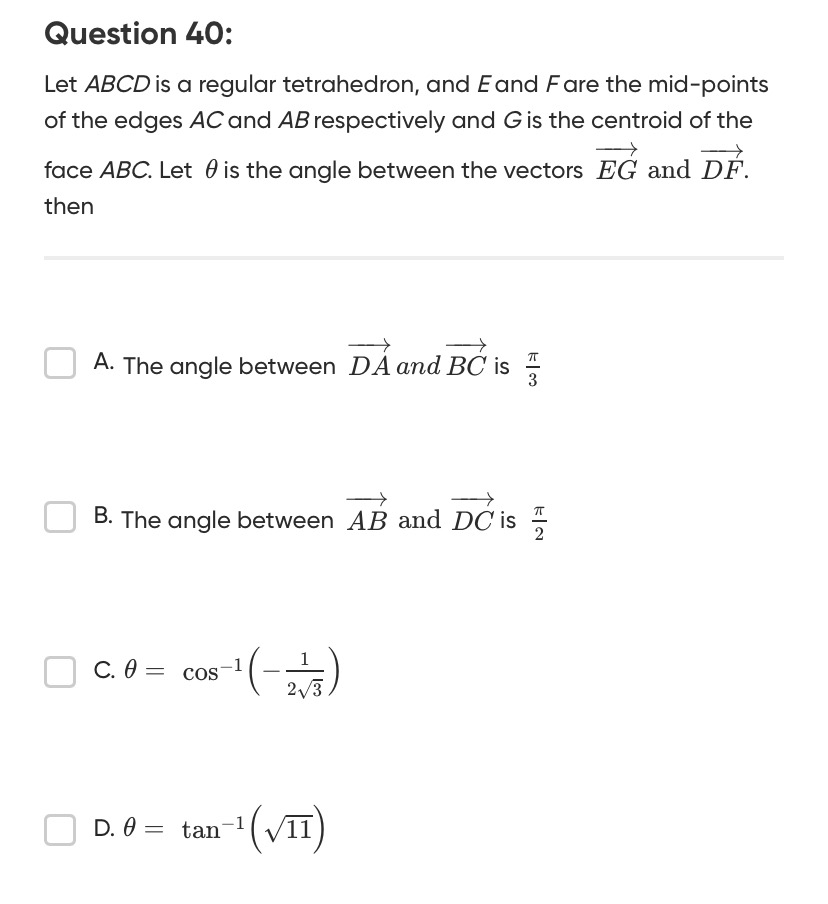Question
Question: Let $ABCD$ is a regular tetrahedron, and $E$ and $F$ are the mid-points of the edges $AC$ and $AB$ r...
Let ABCD is a regular tetrahedron, and E and F are the mid-points of the edges AC and AB respectively and G is the centroid of the face ABC. Let θ is the angle between the vectors EG and DF, then

The angle between DA and BC is 3π
The angle between AB and DC is 2π
θ=cos−1(−231)
θ=tan−1(11)
The angle between AB and DC is 2π
Solution
Let the side length of the regular tetrahedron be a. We place vertex A at the origin, so A=0. Let the position vectors of the other vertices be B, C, and D. For a regular tetrahedron with side length a: ∣B∣=∣C∣=∣D∣=a. The angle between any two edges originating from the same vertex is 60∘ (π/3). Thus, the dot products are: B⋅C=∣B∣∣C∣cos(π/3)=a⋅a⋅21=2a2. Similarly, B⋅D=2a2 and C⋅D=2a2.
E is the midpoint of AC, so AE=21AC=21C. F is the midpoint of AB, so AF=21AB=21B. G is the centroid of the face ABC. The position vector of the centroid of a triangle with vertices A,B,C is 3A+B+C. Since A is the origin, AG=30+B+C=3B+C.
Now, we find the vectors EG and DF: EG=AG−AE=3B+C−2C=62(B+C)−3C=62B−C. DF=AF−AD=2B−D.
To find the angle θ between EG and DF, we use the formula cosθ=∣EG∣∣DF∣EG⋅DF.
Calculate the dot product EG⋅DF: EG⋅DF=(62B−C)⋅(2B−D) =121(2B−C)⋅(B−2D) =121(2B⋅B−4B⋅D−C⋅B+2C⋅D) Substitute the dot product values: =121(2a2−4(2a2)−2a2+2(2a2)) =121(2a2−2a2−2a2+a2)=121(2a2)=24a2.
Calculate the magnitudes ∣EG∣ and ∣DF∣: ∣EG∣2=62B−C2=361(2B−C)⋅(2B−C) =361(4∣B∣2−4B⋅C+∣C∣2) =361(4a2−4(2a2)+a2)=361(4a2−2a2+a2)=363a2=12a2. ∣EG∣=12a2=23a.
∣DF∣2=2B−D2=(2B−D)⋅(2B−D) =41∣B∣2−B⋅D+∣D∣2 =41a2−2a2+a2=a2(41−21+1)=43a2. ∣DF∣=43a2=2a3.
Now, calculate cosθ: cosθ=(23a)(2a3)a2/24=4a2(3)2a2/24=3a2/4a2/24 cosθ=24a2⋅3a24=724=181.
Let's check the given options: A. The angle between DA and BC is 3π. The angle between AD and BC is π/2 (as their dot product is 0). The angle between DA and BC is also π/2. So, A is false.
B. The angle between AB and DC is 2π. The angle between AB and DC is π/2 (as their dot product is 0). So, B is true.
C. θ=cos−1(−231). This implies cosθ=−231. This is not 1/18. So, C is false.
D. θ=tan−1(11). If tanθ=11, then sec2θ=1+tan2θ=1+(11)2=1+11=12. So, cos2θ=sec2θ1=121. This implies cosθ=±121=±231. This is not 1/18. So, D is false.
Based on the calculations, only statement B is correct. The calculated value for θ does not match options C or D.
